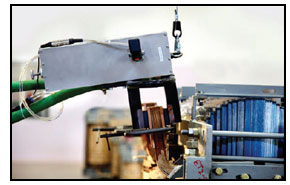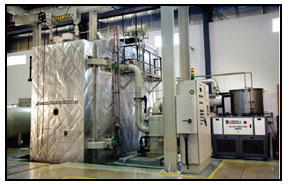 — A. Sridhar Reddy, Managing Director,
Esennar Transformers Ltd
— A. Sridhar Reddy, Managing Director,
Esennar Transformers Ltd
Established in 2000,
Esennar Transformers Ltd is a contemporary
transformer manufacturer based in Hyderabad. It recently entered
the 132kV league and is aiming at 220kV in the next two years.
Electrical Monitor met up with
A. Sridhar Reddy at the recent
Elecrama 2012 in Mumbai. In a freewheeling conversation, Reddy
gives new thinking on old problems facing the industry. He strongly
feels that much efficiency can be introduced into the transformer
industry by just a few policy changes.
Can you take us through the type of transformers made
by Esennar?
We, at Esennar, manufacture transformers of various ratingsright
from 50kVA to 50MVA and from the 11kV class to the 132kV
class. Our manufacturing plant is located in the suburbs of
Hyderabad.
Any immediate expansion plans?
We recently geared up to the 132kV class and in the next two
years, we should advance to the 220kV class.
Talking about concerns faced by transformer makers, we hear of
CRGO shortages.
You are right. CRGO was a problem but about a year ago. The
present market has improved a lot. CRGO availability has now
become better. Posco (the Korean steel maker) has also put up its
unit here (in India). We also have the choice of getting supplies
directly from the manufacturer. In short, the CRGO situation has
improved a lot over the past one year or so.
Do you see a positive impact of the Steel Quality Control order that
mandates consumption of only BIS-certified electrical steel?
Yes. Definitely, there is going to be a positive impact. With this
order, one can expect availability of scrap CRGO to reduce
drastically. Hence, in future, we expect that only prime material
will be available and this is going to benefit the industry as well as
the entire power sector.
We feel that the government's L1 procurement policy is giving rise
to a large number of players in the unorganized sector. What
is your view?
Basically, the L1 policy is killing the quality market. Everybody is
trying to reduce prices, and this is possible only by cutting corners.
Frankly, it is the government and the state electricity boards that
have to be blamed for the L1 system that is being followed.
What then could be alternatives?
One thing that could be done is that before allowing anybody to
participate in the tender, the procurer (electricity board) should
approve the manufacturing facilities of the suppliers. To produce
quality goods, there should be a minimum level of manufacturing competence, which is never checked in the L1 tendering process.
If you look at a transformer tender, everything is specified
(quantity of copper, oil, core, etc). There is hardly anything for the
transformer manufacturer (designer) to do! What I feel is that if
the board has all the technical details, the best thing would be to
calculate the raw material cost. You will be surprised that the L1
price is almost always lower than even the raw material cost! This
is possible only because suppliers are cutting costs and
compromising on quality in the process.
 Do you think that there some progressive states that are trying to
come out of the L1 culture?
Do you think that there some progressive states that are trying to
come out of the L1 culture?
Yes, in a couple of states, we find that prices are better. Secondly,
BEE has now made it mandatory for distribution transformers
to carry a minimum of one-star rating. This has forced utilities
to go in for better transformers. Again, I must say here there
are cases when three-star and four-star rated distribution
transformers are being sold at prices lower than those before
the rating.
How is this possible?
Once again, due to cutting costs. Nothing else!
Would then the BEE mandate have any impact?
I think the Bureau of Energy Efficiency is also amongst the
culprits! I don't think BEE has worked to find out if the losses
that it is specifying for transformers (load-losses) are resulting
in any savings to the nation. BEE seeks to lower losses because
it believes that "power saved is power generated". While we
agree with this, BEE seems to be forgetting that copper (the
main raw material in a transformer) is also a precious resource.
In the Indian context, the only way to improve the performance
of a transformer is to use more copper. Indian transformers
eventually tend to use much more copper than their European
counterparts. Our 100MVA transformer is equivalent to a
315MVA European transformer, in terms of copper usage.
Hence, we are using three-times more copper to achieve the
same transformation capacity. In other words, the efficiency of
copper usage is only one-third. Hence, even these aspects need
to be monitored.
I think all these agencies (like BEE) are "controlled" by
some manufacturers. By "control", I mean that agencies
take data only from certain manufacturers. I feel that data
provided by a handful of companies is taken blindly, and
policies are made accordingly. The best way is to first find out
real technical resources-people that have worked extensively
in the transformer industry-take data from them, and then
formulate policies.
We observe that different state utilities have their own
specifications that prevent equipment manufacturers from
achieving economies of scale.
I agree with you. I feel that instead of utilities specifying the
technical parameters (weights, losses, etc) for transformers,
which, as I said, leaves nothing for the transformer maker to do,
there should be an exercise of inviting all transformer manufacturers to freely design a transformer. From all such
designs, the best must be selected and this should be made as the
national standard. This would also help all the suppliers to achieve
uniformity.
What is your view on competition from Chinese suppliers?
China has entered the market in a big way and this was also one of
the reasons that we have slightly pushed back of plans of moving
to the 220kV class. All the large domestic transformer
manufacturers are finding it difficult. The cost of China-made
transformers is 30 per cent lower than the cost of raw material of
India-made transformers!
How does China achieve this?I think it is probably by its government policy of encouraging
exports. Even if we look at raw material costs, China is at an
advantage. While we are buying copper at $8,250 per tonne, the
price in China is $2,600 per tonne. They have a very big advantage.
 We hear that leading Chinese names like TBEA are willing to
setting up shop in India.
We hear that leading Chinese names like TBEA are willing to
setting up shop in India.
Perhaps, China has realized after what happened to the power
BTG equipment industry when companies like BHEL began
opposing cheap imports from China. Now, instead of setting up
new plants, China could also acquire stake in Indian transformer
companies.
How are India-made transformers faring in the global market?In exports too, buyer countries are looking at the lowest-price,
much like what is happening within our country. China is also a big
competitor to all other countries in the global market. The exports
market is also managed by agents (and not actual buyers) who
look at the lowest price. The world is like a global village, where
everybody is fishing for L1!
Are industry associations effectively carrying your concerns to
the government?
I think they are not! I am admitting this out of personal experience.
Around a year and a half ago, I made representations to the
government about the problems that transformer manufacturers
in Andhra Pradesh face. We have to pay VAT of 14.5 per cent as
against 2 per cent payable in other states. This gives us a
disadvantage of 12.5 per cent. If the average price of a
transformer is say Rs.10 lakh. People cannot afford to pay Rs.1.25
lakh extra. We have taken up this case with leading industry
associations but there has been no response. We are now trying to
set up an industry association of transformer manufacturers in
Andhra Pradesh. At a national level, representation of the industry
in trade associations is very low. Out of an estimated 2,785
transformer manufacturers in India, the leading industry
association's membership will not be more than 25 per cent.
Please summarize your vision for Esennar.
We, at Esennar, would like to restore the trust and reliability that
the Indian transformer industry had. We want to establish
ourselves as a good and reliable brand.